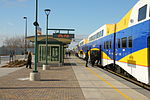Champlin, Minnesota
1852 establishments in Minnesota TerritoryCities in Hennepin County, MinnesotaCities in MinnesotaMinnesota populated places on the Mississippi RiverPopulated places established in 1852 ... and 1 more
Use mdy dates from July 2023

Champlin ( CHAMP-lən) is a city in Hennepin County, Minnesota, United States. The population was 23,919 at the 2020 census. Champlin is a northern suburb of Minneapolis. U.S. Highway 169 and Hennepin County Road 12 (CR 12) are two of the main routes in Champlin.
Excerpt from the Wikipedia article Champlin, Minnesota (License: CC BY-SA 3.0, Authors, Images).Champlin, Minnesota
Richardson Avenue East,
Geographical coordinates (GPS) Address Nearby Places Show on map
Geographical coordinates (GPS)
| Latitude | Longitude |
|---|---|
| N 45.188888888889 ° | E -93.3975 ° |
Address
Richardson Avenue East 1
55316
Minnesota, United States
Open on Google Maps











